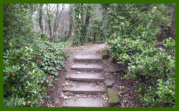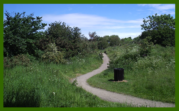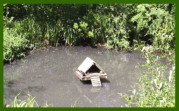Information about the Park
Blundellsands Key Park: Information for Members
What is the Park?
The Park is an enclosed area of approximately 20.67 acres / 8.37 hectares, containing a variety of landscapes and habitats including open dune, vegetation and wooded areas. There are a number of walks, including a view of the Mersey estuary from the highest point, and a children’s play area. The Park is big enough for users to enjoy a sense of space as they walk around it.
How did the Park come into being?
In 1905 the Blundell family, the major landowners in the area, put the land which now forms the Park into a trust for the benefit of the residents of Blundellsands. As a result the Park is, in perpetuity, a safe area for Members’ quiet enjoyment allowing them to walk in a variety of semi-natural landscapes.
Who can join?
Our catchment area is the L23 postcode. Members must pay the fees set by the Trustees each year and comply with the Park’s rules. Any full time resident in the area who meets these requirements can be a Member, subject to the limit the Trustees place on numbers to avoid overcrowding. Members who move away from the area cannot retain their memberships as this would not be consistent with the purpose of the trust.
Who runs the Park?
The Park is a charity run by a small group of volunteer Trustees who give their time freely, pay the same membership fees as everyone else and receive no payment or benefits in kind. The Trustees meet regularly, both as a group and with the Wardens.
How does it work?
Each Member has a key allowing access to the Park for the Member, those living permanently in the Member’s household plus up to two guests per visit. There are no specific opening and closing times.
The Park’s locks are changed each September and new keys issued to Members who wish to continue and have complied with the rules. Keys from previous years will no longer work and are handed in. We use special keys which locksmiths will not copy, and which have the advantage over electronic entry devices that they cannot be hacked or easily damaged.
Memberships are not transferable, even to friends or family, and it is not our policy to allow them to be handed down from one generation to the next.
The annual key change is usually in the second week of September. Notice is given to Members by a series of emails, by a notice on our website and by notices fixed to the Park gates approximately six weeks beforehand.
How can people become Members?
The process for applying is set out on the Membership page on our website. To avoid the Park becoming over-crowded and damaged, the Trustees have limited the number of keys issued to 800, and maintain a waiting list by date of application. After each year’s membership renewal, the Trustees assess the number of vacancies and offer new memberships to the next applicants on the waiting list.
Unprecedented demand during the pandemic meant that we had far more people on our waiting list than ever before, and had to close the waiting list for the time being. We currently have over 400 people on the waiting list.
The waiting list was closed for several years until November 2023. Any applications or requests sent in while the list has been closed will not be treated as valid applications and will need to be re-submitted when it opens.
How many people have access to the Park?
The number varies from year to year, but during the 2023/24 membership year, our records show that the 800 keys issued enabled a total of 3226 people, being Members and those living with them, to have access to the Park throughout the year.
How is the Park’s income used?
The money we receive from membership fees and donations is our only income. The Trustees employ a full time Warden, Paul who supervises the Park during the week, supported by a part-time assistant Warden Vince, who also acts as our weekend Warden, supervising the Park on Saturdays and Sundays. The Wardens also help maintain the Park. We employ a Secretary to help with administration. Our income is used to pay for these posts and the cost of maintaining the Park’s paths, plants, trees, equipment, utilities, fabric and wildlife.
What do Members use the Park for?
The Trustees aim to achieve a balance between different types of Park users. Some are primarily attracted by the children’s play area, some by the opportunity to exercise pets and some by the chance to enjoy walking in the Park and taking in their surroundings in relative peace and quiet. It is important to us that all of these different types of user co-exist peacefully and enjoy the Park’s amenities.
Park rules
The Trustees set the rules, which are on our website, and also on display in the Park. The rules are designed to ensure responsible enjoyment by all Members.
Particularly important rules are that lending your key to non-members is never allowed, Members should not bring in more than two guests on any visit, children aged 12 or over cannot use the play equipment (this is an insurance requirement), cycling, using scooters and ball games (not permitted under the trust deed) are not allowed anywhere in the Park and dog owners must keep their dogs under control at all times and always pick up after them. We expect Members to know the rules and comply with them.
The Wardens will periodically ask Members to produce their keys for inspection and identify themselves, to ensure that the rules are being observed, and Members are expected to co-operate fully. It is also important that Members behave respectfully to other users and the Wardens. The Trustees reserve the right to terminate memberships in appropriate cases.
Communications
Our preferred method of communication is by email. We ask Members to keep an eye on their inboxes for the updates we send from time to time, and to check in case our emails go into their spam folders. We rely on Members to tell us if their email addresses change. Those who do not may miss something important. We do not have the resources to chase Members when emails bounce or are not opened.
Biodiversity
The Park is a designated Site of Local Biological Interest (SLBI) due to its combination of wildlife, plants and habitats. The vegetation reflects its coastal origins, comprising open dune, woodland and gorse scrub as an integral part of a patchwork of largely native habitats. The Park is within the Sefton Red Squirrel buffer zone, so the tree species are mostly small-seeded broadleaf, with some Scots pine content. The perimeter of the park is screened using trees and shrubs forming a link between the woodland blocks.
The Trustees are committed to maintaining and improving the dune habitat of the Park and protecting its many plant, animal and insect species. In making decisions about the upkeep of the Park, the Trustees ensure as far as possible that new plants and trees are native to the area, support the Park’s wildlife and help maintain the Park’s biodiversity.
And finally
We hope that the information set out above helps Members better to understand the Park, and that you enjoy exploring and using the Park. Paul or Vince can often deal with routine queries while you are in the Park. You can also if need be contact the Secretary by email, thesecretary@thekeypark.com, or by calling 07938 196149.
The Trustees, July 2024.



